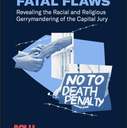

In October 2018, the Washington Supreme Court unanimously struck down the state’s death penalty, finding that it had been “imposed in an arbitrary and racially biased manner.” In reaching its decision in State v. Gregory, the court relied upon a study of twenty-five years of Washington State capital prosecutions that demonstrated that Washington juries were 4.5 times more likely to impose a death sentence on a black defendant than on a white defendant in a similar case. The authors of that study, Dr. Katherine Beckett (pictured, left) and Dr. Heather Evans (pictured, right), join DPIC’s Managing Director Anne Holsinger in the latest episode of our podcast, Discussions with DPIC, to discuss their research and its impact on the court’s decision to strike down the state’s death penalty. Beckett and Evans describe the factors they examined at various stages of capital sentencing, the major results of their study, and the role social science research plays in policymaking.
One of the most dramatic findings of the Washington study was that racial bias was rampant in the state’s capital sentencing outcomes even though there was no statistical evidence of racial discrimination in prosecutorial decisions on whether to seek the death penalty. “The research literature has identified a number of factors that contribute to bias in decision-making outcomes by juries,” Beckett explained. “We know, for example, that implicit bias is pervasive and affects perception and decision-making. … The death-qualification process is also a contributing factor, so we know that people who are in favor of the death penalty are more likely to exhibit implicit and possibly explicit bias. By excluding people who don’t feel comfortable or are philosophically opposed to the death penalty, we amplify the implicit bias that exists in the general population.” They noted that “substantial changes” would have to be made to the process of jury selection in capital cases in order to reduce the effects of implicit bias.
Although their study profoundly influenced capital litigation in Washington, Beckett and Evans said the information that allowed them to prove discrimination in sentencing may not be available in some other states. Under Washington’s death-penalty statute, the state supreme court was required to conduct proportionality review to determine whether a sentence was disproportionate to others imposed in similar circumstances. As a result, the state courts kept thorough records of the facts of murder convictions that are not necessarily available in other states. The researchers also noted that because the Washington Supreme Court decision was ultimately based on state constitutional law, other state courts might reach a different conclusion even if defendants could show similar patterns of bias in their state sentencing practices. With those caveats, Beckett and Evans believe that courts in other death-penalty states could benefit from similar studies. They noted that the Washington Supreme Court engaged “thoughtfully” and “deeply” with their research and found it heartening that “facts and evidence and rigorous research could be included in a deliberation of how to achieve more equity in the criminal justice system.”
(Discussions with DPIC, The Effect of Race on Sentencing Decisions in Washington, March 15, 2019; Katherine Beckett and Heather Evans, Race, Death, and Justice: Capital Sentencing in Washington State, 1981 – 2014, Columbia Journal of Race and Law, Volume 6, Issue 2, 2016.) Listen to Discussions with DPIC: The Effect of Race on Sentencing Decisions in Washington. Read case documents in State v. Gregory. See Race and Podcasts.



